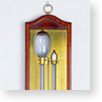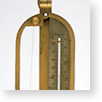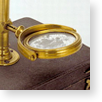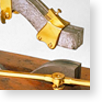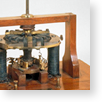The triumph of the experimental method in the 17th century and the development of new instruments led to rapid progress in the study of natural processes, demonstrating the laws that governed them and revealing phenomena imperceptible to the senses. The first room contains instruments used for atmospheric measurements, for studying the phenomena of light, and for microscopy. Barometers and thermometers allowed increasingly precise measurements, while microscopes vastly enhanced the powers of vision, revealing amazing aspects of the microcosm. In the 18th century new instruments were invented, not only to observe nature, but also to act on it, creating new phenomena. Electrostatic machines attracted enormous interest, opening new horizons to scientific research. Then in 1800 the invention of the electric battery heralded the age of electrodynamics and electrochemistry. In the next room are displayed numerous instruments used to study electric current and its effects. Within a few decades, this study led to crucial discoveries, giving birth to electromagnetism, whose practical applications were to trigger a new industrial revolution.
Atmospheric Pressure
In the 18th century the barometer, introduced around the mid-17th century as a laboratory instrument for studying pneumatics, became an indispensable tool ...
(5 objects)
Meteorology
In the second half of the 18th century, systematic observation of meteorological phenomena using increasingly sophisticated instrumentation became standard ...
(12 objects)
Light
To study the phenomena of light, the first optical benches were introduced in the 18th century. Lenses, prisms and mirrors could be mounted on them in ...
(29 objects)
Electricity and Magnetism
Starting from the late 18th century, studies in electricity and magnetism, which had been basically qualitative, began to employ new measurement instruments ...
(15 objects)
Leopoldo Nobili’s Instruments
In the first decades of the 19th century the Italian physicist Leopoldo Nobili (1784-1835) did pioneering work in electromagnetism. He invented the thermopile, ...
(9 objects)
Telegraphs and Motors
After the discovery of electromagnetic phenomena, and with the invention of the electromagnet, the first telegraph systems, electric motors and electric ...










